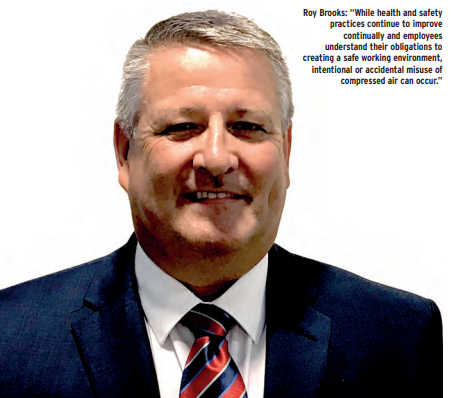Take the pressure

Roy Brooks, technical development officer for the British Compressed Air Society, outlines some of the latest advice in working safely with compressed air.
One of the common challenges that many health and safety managers face is that users can become complacent and overlook the fact most compressed air is pressurised to at least six times atmospheric pressure – and it is this pressurised energy that can create a hazard if not managed properly.
In addition, the noise created by unsilenced compressed air when exhausting to the atmosphere also needs careful consideration to ensure it remains with legal limits.
Avoid contact
While health and safety practices continue to improve continually and employees understand their obligations to creating a safe working environment, intentional or accidental misuse of compressed air can occur. Compressed air injection into the body at any pressure can cause serious injury, or even death, so it is always worth reminding users not to use compressed air to clean off dust or debris from their clothing or skin and to avoid dislodging debris that could cause bodily harm.
Joint responsibility
The Health and Safety at Work act states that an employee must take reasonable care and follow all procedures laid down by his/her employer to create a safe working environment for everyone. To ensure this is achieved, every employee, through the Provision and Use of Work Equipment Regulations should receive training in order to use compressed air equipment in the correct manner.
Additionally, it is important that the appropriate personal protective equipment (PPE) is provided to all using compressed air tools, that it is worn correctly and fits properly. Depending on the application, this can include safety goggles/glasses, ear defenders, gloves and face masks.
Equipment types and hazards
There is a wide range of handheld pneumatic equipment and each type has its own associated hazards. These fall into two groups; where the compressed air drives a motor, e.g. grinders, sanders, nut runners or where the compressed aiis used directly through a nozzle, e.g. blow guns, spray guns. These air powered tools give rise to a number of hazards requiring various items of personal protective equipment to be worn to help protect from noise and vibration, sparks and dust.
Sometime, the connection between the hose and tool or the hose clamp can become loose, through wear of tampering. Attention should also be paid to quickrelease couplings, which may not be pushed home properly or have worked loose through wear, To help mitigate against this risk, users should check both the hose itself and its connection with the tool for signs of wear and tear before use.
Blow gun safety
The end of a blow gun must never be blocked, nor pointed at anyone and should not be used for general cleaning purposes, such as cleaning clothing, especially while being worn, or benchOne way to help minimise the risk of injury is to only use blow guns which have some form of safety feature, either a safety-pattern nozzle or a safety mechanism which cuts in if the nozzle becomes blocked. If the blow gun does not have a built-in safety feature, then reduce the pressure to 2 bar or 30 PSI gauge pressure. And ensure that safety goggles or glasses are worn at all times.
BCAS training
BCAS offers a dedicated ‘Working Safely with Compressed Air’ course via its new e-learning portal. The course covers the employer’s and employee’s responsibility for safety in the workplace and outlines why air users must know how to work safely and understand the risks involved if good practice is not followed.
For further information about the full range of BCAS training courses on offer, including classroom-based training, visit https://e-learning.bcas.org.uk/ or call 0207 935 2464
https://www.linkedin.com/company/british-compressed-air-society/
-
PPMA 2025
23 September, 2025, 9:30 - 25 September, 2025, 16:00
NEC, Birmingham UK -
Advanced Engineering Show 2025
29 October, 2025, 9:00 - 30 October, 2025, 16:00
NEC, Birmingham UK










